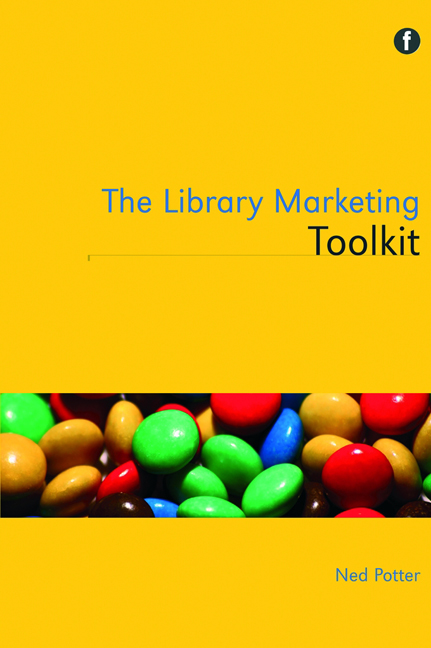Book contents
- Frontmatter
- Dedication
- Contents
- Acknowledgements
- Introduction
- 1 Seven key concepts for marketing libraries
- 2 Strategic marketing
- 3 The library brand
- 4 Marketing and the library building
- 5 An introduction to online marketing
- 6 Marketing with social media
- 7 Marketing with new technologies
- 8 Marketing and people
- 9 Internal marketing
- 10 Library advocacy as marketing
- 11 Marketing special collections and archives
- A final word on marketing libraries
- Appendix: Glossary of Web 2.0 tools and platforms
- References
- Index
5 - An introduction to online marketing
Published online by Cambridge University Press: 08 June 2018
- Frontmatter
- Dedication
- Contents
- Acknowledgements
- Introduction
- 1 Seven key concepts for marketing libraries
- 2 Strategic marketing
- 3 The library brand
- 4 Marketing and the library building
- 5 An introduction to online marketing
- 6 Marketing with social media
- 7 Marketing with new technologies
- 8 Marketing and people
- 9 Internal marketing
- 10 Library advocacy as marketing
- 11 Marketing special collections and archives
- A final word on marketing libraries
- Appendix: Glossary of Web 2.0 tools and platforms
- References
- Index
Summary
There now follows a suite of three related chapters all about the internet in its various manifestations, and using it to market successfully. Although Chapters 6 and 7 deal with more advanced Web 2.0 concepts, it would be wrong to describe this introduction to online marketing as ‘the basics’ – i's more like the fundamentals. As such, case study contributions are of a particularly ‘howto’ bent in this chapter: David Lee King gives seven top tips for the library website, Aaron Tay details the importance of a library presence on mobile devices, and Alison Wallbutton gives advice on how to market with email.
The library website
Despite the emergence of Web 2.0 applications and social media activities (which we shall get onto later) the library's main website is still an absolutely essential marketing tool for several reasons. Most obviously, library website use is up exponentially for most libraries in the last few years. Users and potential users will be Googling your library, so what they find online will make a huge difference as to whether they then visit your premises in person.
Physical footfall is simply no longer fit for purpose as a measure of a library's success, because so much can be done online – every book renewal or reservation made using the internet is a visit to the library building saved. Often the media – and perhaps those holding the pursestrings for libraries – will take a reduction in footfall as proof that a library is no longer being used as much, making it a soft target for cuts. It's vital that in marketing libraries, to both internal and external stakeholders, that we emphasize the compound number of visits – physical and online combined. The Chartered Institute of Public Finance and Accountancy conducted a survey (CIPFA, 2010) about library use in the UK during the preceding five years. Physical attendance was found to be down by around 4%; online activity was up by a massive 49% across the country in the last year alone. As discussed above, this would more than account for the drop in footfall – in fact, one could interpret the statistics as representing an overall increase in the use of libraries.
- Type
- Chapter
- Information
- The Library Marketing Toolkit , pp. 79 - 90Publisher: FacetPrint publication year: 2012

